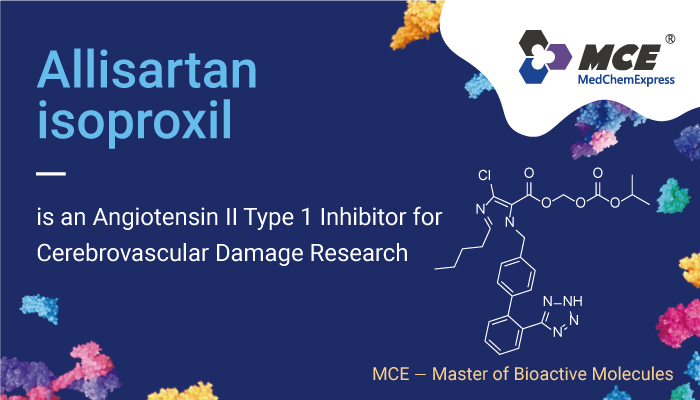Angiotensin II Type 1 Receptor (AT1R) belongs to the G protein-coupled receptor family and is an important part of the renin-angiotensin-aldosterone system (RAAS). The RAAS regulates a variety of physiological functions such as vasoconstriction, fluid volume regulation, cardiac output, cell growth, and vessel wall integrity. AT1R utilizes multiple signaling cascades to cause hypertension, cardiovascular remodeling and target organ damage. Antagonists of AT1R can block the binding of angiotensin II to AT1 receptors, thereby down-regulating the downstream effects of AT1 receptors. Such as inhibiting the contraction of vascular smooth muscle, reducing the excitability of sympathetic nerves, reducing the synthesis and release of adrenal aldosterone, etc. Here we introduce a potent AT1R non-peptide antagonist, Allisartan isoproxil, with antihypertensive activity.

Allisartan isoproxil is orally active and modulates the RAAS system by antagonizing AT1R.
Allisartan isoproxil has a stroke-preventive effect and a protective effect on cerebrovascular injury. It can reduce the mortality rate, prolong lifespan, and prevent cerebrovascular, cardiac and aortic damage in stroke-prone rat RHR-SP. In spontaneously hypertensive rats (SHR), ALS-3 effectively and long-term lowers blood pressure and prevented cardiac and aortic damage. And reduces body weight in Sprague-Dawley rats at doses of 80-320 mg/kg/day.
Allisartan isoproxil (30 mg/kg/day; p.o.; 55 weeks) also significantly reduces mortality and prolongs lifespan in stroke-prone renovascular hypertensive rats. In two-kidney one-clip (2K1C) renal hypertensive rats, it inhibits vascular smooth muscle contraction and reduces adrenal aldosterone levels. It also reduces serum MDA and NAD(P)H oxidase expression levels, effectively inhibiting oxidative stress.
In conclusion, Allisartan isoproxil is a potent AT1R antagonist and can effectively reduce blood pressure. It inhibits RAAS activity by blocking AT1 receptors, and has antihypertensive and cerebrovascular protective effects.
References:
[1] Forrester SJ, et al. Physiol Rev. 2018 Jul 1;98(3):1627-1738.
[2] Liu Y, et al. Drug Chem Toxicol. 2013 Oct;36(4):443-50.
[3] Ling QS, et al. Acta Pharmacol Sin. 2021 Jun;42(6):871-884.